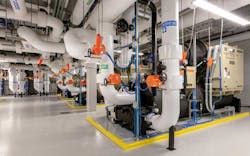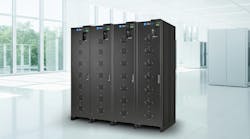Meta Running Server Rooms at 90 Degrees to Slash Water Impact
SAN ANTONIO – As it seeks to become a water-positive company, Meta is slashing the water use of its data centers by running its servers in warmer and drier environments, the company said Tuesday.
In recent testing, Meta has begun operating its data halls at 90 degrees, a move that could further slash the energy and water impact of its massive digital infrastructure. The company has already pushed humidity levels as low as 13 percent in server rooms across its global fleet of data centers, which will save millions of gallons of water annually.
The Meta engineering team disclosed new details of its broad-based water conservation effort at the 7×24 Exchange Fall Conference. In addition to optimizing its data halls, the company has undertaken a multi-faceted optimization of the processing and filtration of the water it uses.
“We have a ruthless focus on reducing our water usage,” said James Monahan, Data Center Facilities Engineering Director for Meta. “Being water positive means we are going to restore more water back to the environment than we consume.”
That’s a huge challenge. The data centers which power Facebook, Instagram, Messenger and WhatsApp are already some of the most efficient in the world. In seeking to further slash its water impact, Meta is pushing the boundaries of its server environments to wring additional gains.
To do this without damaging its IT equipment, Meta has run pilot programs in which it adjusts the climate in one half of a data center, and then compares its performance against the other half. In 2020 it conducted successful pilots of lower humidity levels, and this past summer it raised the upper limit for operating temperature from 85 to 90 degrees.
“We’re pushing our infrastructure in a safe, data-guided matter,” said Krishna Somayajula, Data Centers Facilities Lead, Mechanical Engineering at Meta. “We are closely tracking the failure and ticket rates (on the temperature change) to determine the impact before we make a decision.”
Why Operating Temperatures Matter
In response to growing concerns about climate change and water scarcity, Meta (then Facebook) said in 2021 that it intends to be water positive by 2030. The announcement followed the unveiling of a new data center near Phoenix, which raised concerns that the facility could tax the region’s water resources during a drought.
The company has invested in water restoration projects in New Mexico, Arizona, Texas, Utah, Oregon, and California that will replenish more than 850 million gallons of water per year.
Running at warmer temperatures means companies need less cooling to maintain their target temperature, or set point. It also reduces the amount of power and water in cooling systems. Lowering the humidity also saves water. Meta operates more than 40 million square feet of data center space, meaning that even minor improvements can create ripple effects when applied across its entire fleet of data centers.
Through the mid-200s, most data centers operated in a range of 68 to 72 degrees F. But in 2008 Google said it would boost its set point to 80 degrees, saying the move had little impact on server failure rates. Hyperscale operators have continued to fine tune their cooling to boost their energy efficiency, as seen in Meta’s upper range of 85 degrees.
The same strategies can save water. Microsoft said last year that it would operate its data centers at warmer temperatures as part of a bid to slash its water usage by 95 percent.
Testing Targets Temperature, Humidity
By that time, Meta had already gone through several rounds of testing to save water by lowering the humidity in its data centers using evaporative cooling. The company initially sought to keep humidity between 20 and 30 percent, but then tightened that range to 20 to 22 percent. In 2020, Meta did a pilot in its Las Lunas, New Mexico data center which it ran half of a data center at 13 percent humidity.
The test showed that key metrics like electrostatic discharge remained in target ranges, while Meta was able to reduce water use by about 40 percent. Water savings in other regions may range between 10 and 65 percent, depending on the climate.
“This data gave us the confidence to change the humidity from 20% to 13% across our fleet,” said Somayajula.
Meta also changed the setting in its cooling systems using indirect evaporative cooling, adjusting the wet bulb temperature – a measure of heat rejection conditions in adiabatic cooling systems – from 44.6 degrees to 48.2.
The Meta engineering team is still reviewing the results of the pilot with the 90-degree setting, but Somayajula said that thus far “The results from this test these tests are very promising.”
Savings Seen in Filtration, Water Softening
Meta also has tested refinements in the industrial water processing systems that support its campuses, changing setting in how it conducts filtration and water softening.
One area of inquiry was “backwash,” a process which uses water flows to clean collected particles from a filtration system. Testing found that Meta could do backwashing less frequently without diminishing quality, allowing the filtration system to use less water, according to Bharath Gopal, Data Center Facilities Chemical Engineer and one of the Meta presenters at the 7×24 Exchange session.
Gopal said Meta found similar savings in adjusting the frequency of activity in water softening systems used at some of its data centers. These systems typically use brine to remove calcium and magnesium and replace them with sodium ions. Meta found that it can save water and salt with longer regeneration cycles.
“We want to treat the exact amount of water needed,” said Gopal, who said the changes were fairly simple but the add up to millions of gallons of water savings nationally.
Lots of work remains. According to Meta’s 2021 environmental impact report, the company used 678 million gallons of water in its global operations, while its utility power contained another 875 million gallons in water consumption embedded in its electricity production. Meta’s water restoration projects provided water benefits measured at 617 million gallons.
The huge numbers underscore the size of Meta’s challenges and its commitment, and explain the breadth of the holistic efforts to slash the water impact of its data centers.
“We’re going to continue to focus on all aspects of this,” said Monahan. “It’s an area we are passionate about, and invest heavily in.”
About the Author



